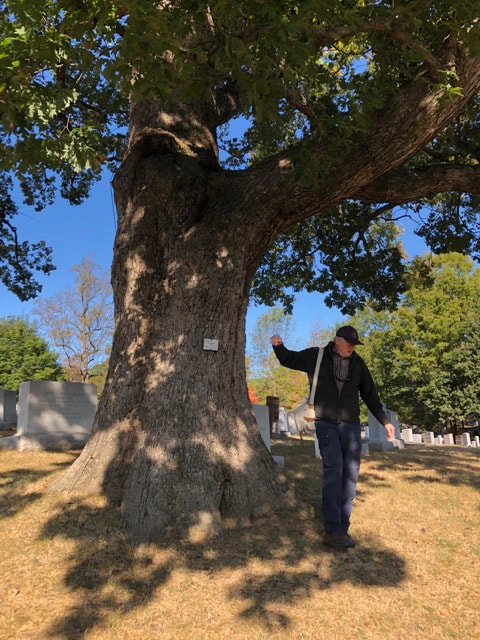|
Dawn Szelc LDG Secretary, Clear Blue Landscapes On this brilliant fall morning over 60 people (from the Landscape Designers Group, Master Gardeners, Trees Stewards, National Park Service and other organizations) had an inspirational and informative visit to Arlington Woods, a remnant stand of Mid-Atlantic Mesic, Mixed-Hardwood Forest adjacent to Arlington National Cemetery.  The tour was led by Rod Simmons, Natural Resource Manager/Plant Ecologist who highlighted unique features of this “old age forest” that once covered the uplands and hillside of property owned by George Washington Parke Custis. Rod described features of the Chestnut Oak and Oak Heath Forest communities found on the upper areas of the property, and Acid Oak Hickory in the ravines and lower benches. Rod further clarified that “old age forests” are ones established post-colonial settlement, (such those as seen at Monticello or Chapman Forest) in contrast with “old growth forests” more common in the west which remain intact due to their more remote or inaccessible locations Evidence of the current drought was seen, even in the larger oak and hickory trees. Rod cautioned against the removal of stressed trees until next year and encouraged evaluating them in late spring. Rod also noted that American Ash saplings were abundant despite deer browse and the loss of larger trees killed by the Emerald Ash borer and suggested prudent use of benzodiazepine injections in larger saplings to enhance pest resistance. He also highlighted the excellent work that the National Park Service does with environmental planning and projects, including recent stream and stormwater conveyance work seen onsite. Rod’s amazing breath of knowledge and keen powers of observation were further evidenced by his description of an artifact found on site and carefully replaced where found. Once again, the beauty and complexity of our native forests were an inspiration to all! A bio for Rod:
“Rod Simmons is the Plant Ecologist for the City of Alexandria, a member of the Virginia Botanical Associates (a nonprofit scientific organization dedicated to the study of Virginia’s flora), a board member of the Virginia Native Plant Society, and Botany Chair of the Maryland Native Plant Society. A life-long resident of northern Virginia, Rod has an encyclopedic command of the local flora.” https://armn.org/2012/12/19/rod-simmons-on-ecological-restoration/ An interesting description of the area written by Rod Simmons: ArlingtonWoods Through The AgesPDF.pdf Thank you to the groups that joined us that day:
0 Comments
by Clara Aleman, RLA, ASLA
Why is her new book titled Deer-Resistant Design? Well, as she so simply stated, and bears repeating, because “good design is more important than ever.” Karen found that many home owners with deer in their yard, tend to come for garden advice only after many failed attempts that took up time, effort and money. In her new book, she offers homeowners that share their yard with deer to - start with a plan – a plan that includes deer as part of the garden experience. She offered 8 key design principles for a deer-resistant garden. 1. Establish the hardscape. Think about shapes, materials, sight lines to create a sense of order. 2. Non-edible focal points (water features, containers, structures) – distract and re-focus attention. 3. Color palette – Be strategic and create a sense of unity and order. 4. Varying textures and heights of plants – easier to “hide” minor damage than a sheared hedge. 5. Foliage framework – taste testing less obvious than if lower buds are nipped off. 6. Plant selection – focus on deer resistant plants (levels A and B) and think in combinations. 7. Avoid monoculture – because you KNOW the deer will have to taste it…. 8. Barriers – re-route and/or protect with sprays, temporary fencing etc. (Important for year round browsing as well as fall rutting/antlering). I don't want to give much more away, because I highly recommend you READ THE BOOK! And, please check out her website ... for lots of happy reading! |
AuthorsLDG is a non-profit corporation dedicated to the exchange and enhancement of knowledge relevant to the landscape design profession. We are a group of professional designers in the metropolitan Washington, DC area. Membership is meant for students studying and professionals employed in landscape design or associated professions (i.e. arborists, installers, contractors, etc.). Archives
October 2023
CategoriesPast Newsletters can be found in the Members Only Section of the LDG Membership Connection. You must sign in to view these files.
Past Newsletters |
|
Search for a Landscape Designer in Your Area:
|







 RSS Feed
RSS Feed
